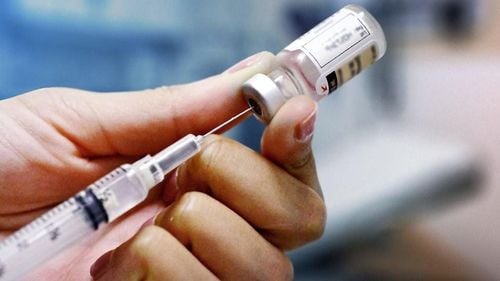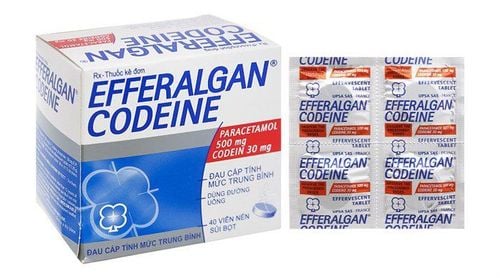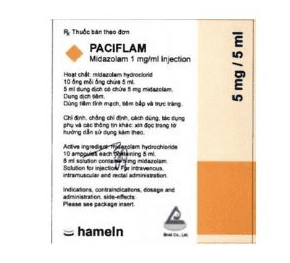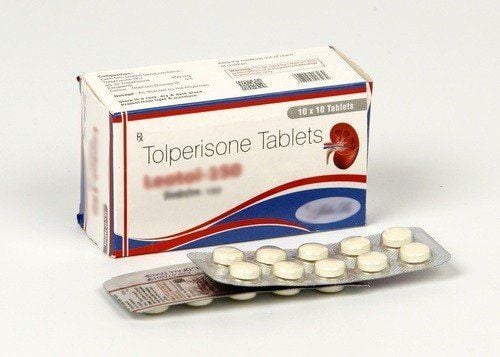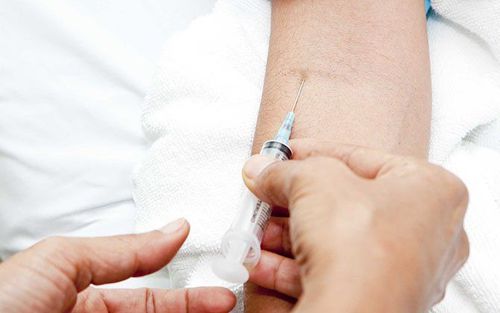This is an automatically translated article.
Copaxone is a prescription medication used to treat relapsing forms of multiple sclerosis (MS), including clinically isolated syndromes, recurrent disease, and active secondary progressive disease. movement in adults. To ensure the effectiveness of using Copaxone, users need to follow the instructions of their doctor and refer to the following article for more information about the use of Copaxone.1. What does Copaxone do?
1.1. What is Copaxone? Copaxone belongs to the group of drugs that are immunomodulators, which work with the immune system.
Copaxone medicine includes the following ingredients:
Active ingredient: 20 mg (40 mg) glatiramer acetate ~ with 18 mg (36 mg) glatiramer. Excipients: Mannitol, distilled water for injection. Copaxone is prepared in the form of a transparent solution for injection, with a strength of 20 mg or 40 mg. Box of 7, 28 or 30 syringes pre-filled with 1 ml solution for injection.
Copaxone drug recommended for use in adults. For 12 to 18 year olds, published data are limited.
1.2. What disease does Copaxone treat? Copaxone is approved by the FDA as a prescription medication used to treat certain forms of multiple sclerosis (MS) in adults.
Clinically isolated syndrome (CIS). With CIS, you have an episode of MS-like symptoms that lasts for at least 24 hours. CIS may or may not develop into multiple sclerosis. Relapsing-remitting MS syndrome (RRMS). With RRMS, you have periods when your MS symptoms recur (flare up), then periods when your MS symptoms go into remission (improve or go away). Secondary progressive multiple sclerosis (SPMS). With active SPMS, the condition gets worse and worse, but you still have periods of relapse. During a relapse, your symptoms get noticeably worse for a while. Contraindications:
Patients who are allergic to the main ingredient glatiramer or any of the excipients of the drug. Patients with primary or secondary multiple sclerosis.
2. Usage of Copaxone
2.1. How to use Copaxone Drug Copaxone is administered subcutaneously. Do not inject into your veins or muscles. Do not inject Copaxone into areas of skin that are red, swollen, lumpy, scarred, or pitted. Avoid injecting in areas of skin with birthmarks, stretch marks, or tattoos. Injection area: abdomen, thigh, arm or side The drug is administered by the medical staff on the first injection and then instructs the patient to self-inject at home. Copaxone is stored cold, so when taking the medicine out of the refrigerator, let it rest at room temperature for about 20 minutes to cool down before injecting. The drug is colorless or slightly yellow and has no cloudiness. If the drug is frozen, it must be discarded, not injected. Each syringe is for one person use, do not reuse. Change injection sites continuously. Follow the exact dose of Copaxone prescribed by your doctor. Do not rub or massage your Copaxone injection site for at least 24 hours after you have had the injection. 2.2. Dosage of Copaxone Dosage is recommended for all three forms of CIS, RRMS and SPMS. This is a reference dose, specific dosage should be individualized.
Syringe 20 mg/mL, administered subcutaneously once daily. Syringe 40 mg/mL, administered subcutaneously three times per week. Try to maintain the dose on fixed days such as even days, Monday, Wednesday, Friday, or odd days such as Tuesday, Thursday, and Saturday. Ensure a gap of at least 48 hours between doses. Treatment for missed dose:
If you miss a daily dose of Copaxone 20 mg, inject it as soon as you remember. If it is almost time for the next dose, stop the missed dose and wait until it is time for the next dose. Do not inject two doses at the same time. If you miss a dose of Copaxone 40 mg three times a week, inject it as soon as you remember. After that, wait at least 48 hours before injecting the next dose. You can resume your usual dosing schedule the next week, always remembering to wait at least 48 hours between doses. Call your doctor who is uncertain about when to give your next dose of Copaxone after you miss a dose. Treatment in case of overdose:
If there are any unusual signs or known side effects but no symptoms improve while taking Copaxone, you should immediately notify the treating doctor for treatment or treatment. suitable treatment.
3. Note when using Copaxone
Use the correct route of injection and the recommended injection site. Do not use discolored, frozen, cloudy medicine Store the medicine according to the recommendations to avoid changing the drug. The long-term use of the drug and the dose and duration of treatment are not the same for each patient. Patients should be provided with reactions associated with at least one of the following symptoms that may occur within minutes of Copaxone injection: vasodilation (flushing), chest pain, dyspnea, palpitations or fast heart rate. Most of these symptoms are short-lived and resolve on their own without any sequelae. If a serious side effect occurs, the patient must immediately stop Copaxone treatment and contact a physician or any emergency physician. Copaxone should be used with caution in patients with pre-existing cardiac disorders. These patients should be monitored regularly during treatment. Antibodies to glatiramer acetate were detected in the serum of patients on chronic daily treatment with Copaxone. Maximum levels are reached after an average of 3-4 months of treatment, then gradually decrease and stabilize at a level slightly higher than baseline. Rare cases of serious liver injury have been observed (including hepatitis with jaundice, liver failure and in isolated cases requiring liver transplantation). Liver damage occurs days to years after starting treatment with Copaxone. Most cases of severe liver injury resolve when treatment is stopped. In some cases, these reactions occur with excessive alcohol consumption, existing or history of liver injury, and use of other potentially hepatotoxic drugs. Patients should be regularly monitored for signs of liver damage and instructed to seek immediate medical attention in case of symptoms of liver damage. In the event of clinically significant liver injury, discontinuation of Copaxone should be considered.
4. Copaxone side effects
Mild effects:
Reaction at injection site, which can cause redness 22-43%, pain 10-40%, itching 6-27%, lumps 6-26% or swelling 6-19 % in the area you injected. Facial flushing Skin rash Shortness of breath Anxiety, mood swings or depression. Nausea and vomiting Weakness Infections, such as the common cold or the flu Back pain or other parts of the body Fast heartbeats Sweating more than usual Weight changes, including weight gain or weight loss Most of the side effects mentioned above of Copaxone can go away within a few days or weeks.
Serious side effects:
Liver problems that can be serious, such as liver failure or hepatitis, include the following symptoms:
Pain in the right side of the upper abdomen (abdomen) Jaundice or yellowing of the whites of the skin eyes Fatigue (lack of energy) Post-injection reactions (reactions that happen inside your body shortly after the injection).
Skin lesions at the injection site: Fat atrophy or skin necrosis. Chest pain Allergic reaction. Depression Uncommon:
Abscess, cellulitis, boils, Herpes Zoster, pyelonephritis Leukocytosis, leukopenia, splenomegaly, thrombocytopenia, abnormal lymphocyte morphology Intolerance alcohol, gout, hyperlipidemia, hypernatremia, decreased serum ferritin Confusion state, euphoric mood, hallucinations, personality disorder, suicide attempt. Carpal tunnel syndrome, cognitive disorders, seizures, metabolic disorders, dyslexia, dystonia, motor dysfunction, myoclonic tremor, neuritis, nerve blockade muscle, nystagmus, paralysis, perioral nerve paralysis, dizziness, visual field defect. Cataracts, corneal damage, dry eyes, eye hemorrhage, eyelid narrowing, mydriasis, atrophy Nosebleeds, hyperventilation, laryngospasm, lung disorders, feeling of suffocation Colitis colon, Colon polyps, colitis, esophagitis, periodontitis, rectal bleeding, salivary gland enlargement Arthritis, bursitis, flank pain, muscle atrophy, osteoarthritis Erectile dysfunction, pelvic prolapse, foreskin stenosis, prostate disorders, cervical abnormalities, testicular disorders, vaginal bleeding, vaginal disorders Hypothermia, immediate reaction after injection, inflammation , injection site necrosis, mucosal disorders.
5. How to store Copaxone
The shelf life of Copaxone medicine is 36 months from the date of manufacture.
Store in refrigerator (2°C - 8°C)
Keep out of reach of children.
Above are the uses of Copaxone, hopefully, it will help patients better understand what Copaxone is and how to use it. If you have any further questions, you should contact your doctor for in-depth advice.




